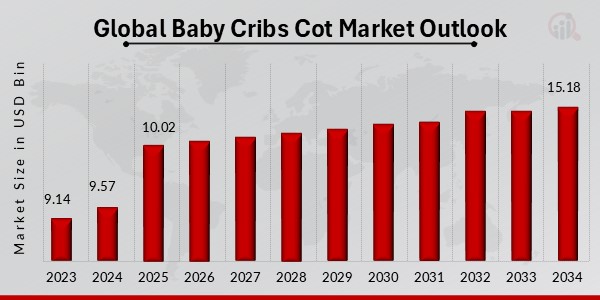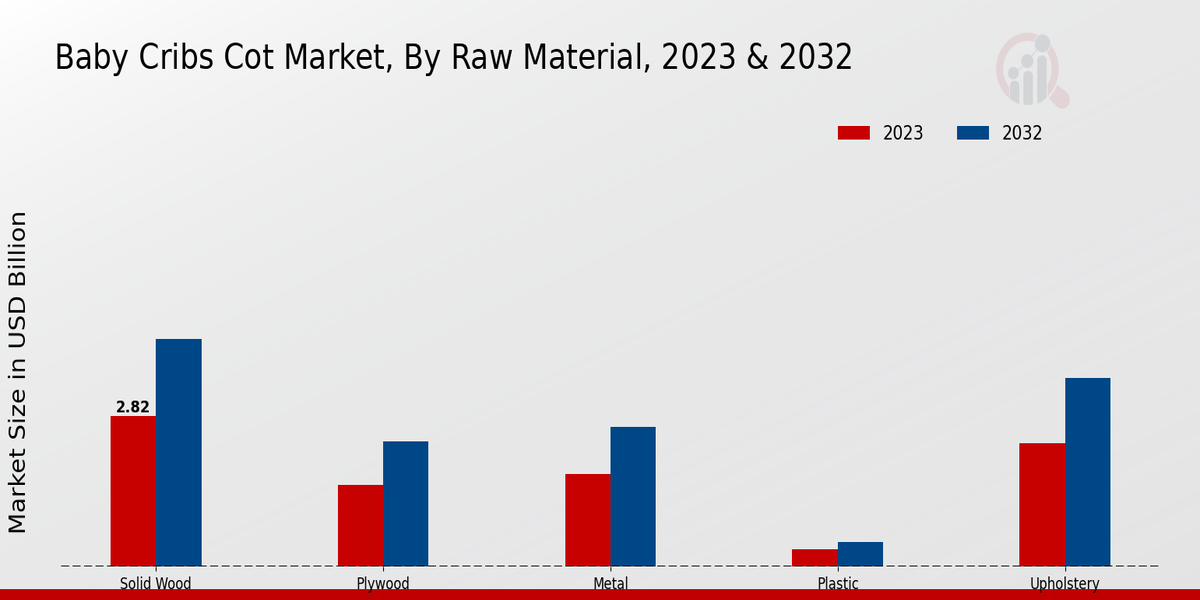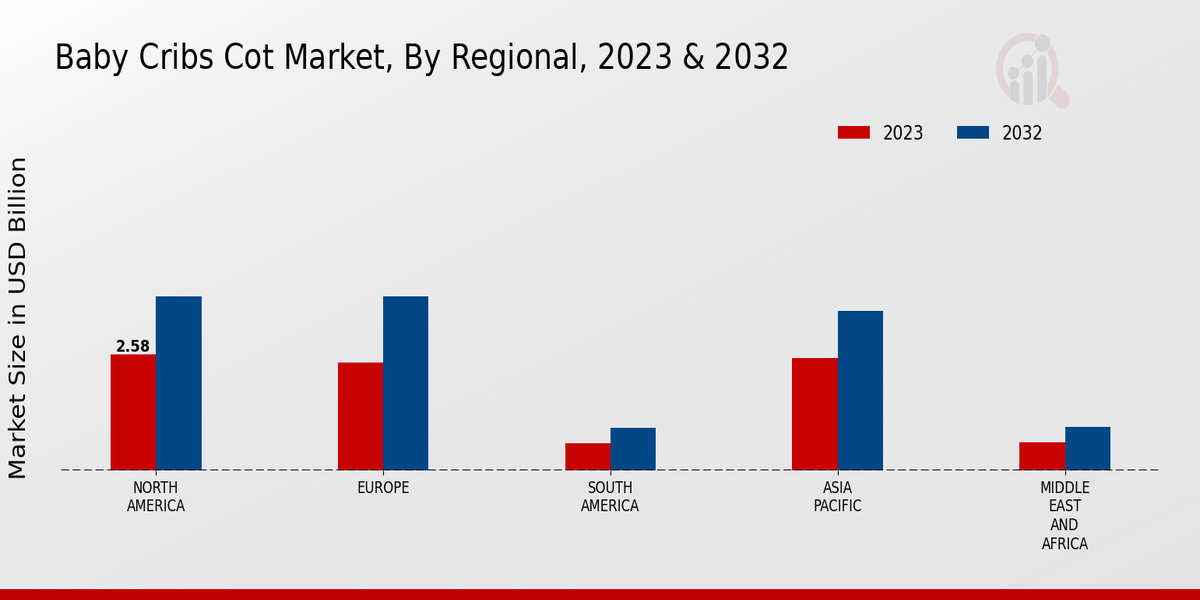Global Baby Cribs Cot Market Overview
Baby Cribs Cot Market Size was estimated at 9.57 (USD Billion) in 2024. The Baby Cribs Cot Market Industry is expected to grow from 10.01(USD Billion) in 2025 to 15.18 (USD Billion) by 2034. The Baby Cribs Cot Market CAGR (growth rate) is expected to be around 4.72% during the forecast period (2025 - 2034).

Source: Primary Research, Secondary Research, MRFR Database and Analyst Review
Key Baby Cribs Cot Market Trends Highlighted
The coming years will see significant growth in the market for baby cribs and cots. The main market catalysts are improvements in living standards, growing awareness about child safety and an increased demand for comfortable and fashionable baby furniture. Furthermore, this industry is also growing due to technological advancements and the introduction of new features, such as cribs that can monitor and lull babies to sleep. Lately, sustainability has become a dominant trend where parents are going for baby products made from eco-friendly or non-toxic materials. Additionally, e-commerce platforms have enhanced market penetration by providing convenience and a wide range of goods to consumers. Manufacturers are therefore focusing on product innovation design aesthetics as well as partnering with big retailers and distributors so as to tap into the rising opportunities within the baby cribs and cots sector.
Baby Cribs Cot Market Drivers
Rising Birth Rates in Developing Countries
The baby cribs and cots market is growing due to the increasing birth rates in developing countries. This has resulted in more and more people choosing to be parents, which has increased the demand for comfortable sleep areas for babies. Asian Pacific, as well as Latin America, have noticed this rise with their population going up daily. Therefore, families will want to ensure that their children can live a good life, which will stabilize the baby cribs and cots market here.
The Baby Cribs Cot Market Industry is ready to take off with the growth in birthrates in developing countries.
Growing Awareness of Infant Safety
Another key driver of the baby cribs and cots market is growing awareness. Mothers and fathers are increasingly understanding the significant role played by a safe sleeping environment for their newborns. Several factors, including media campaigns, government regulations, and the availability of information through online sources, have contributed to this realization. Consequently, parents are more likely to purchase baby cribs and cots that meet the highest safety standards.
Improving knowledge about child safety remains one of the major drivers for growth in this industry.
Increasing Disposable Income
Baby cribs and cots are also said to be in high demand because families have more disposable income. High amounts of disposable income mean higher investments in children’s products. Baby cribs and cots are especially common in developed countries, as these are places where disposable income increases steadily. The same is expected in the future, as premium baby cribs and cots will be widely demanded.
Baby Cribs Cot Market Segment Insights
Baby Cribs Cot Market Raw Material Insights
The raw material segment of the Baby Cribs Cot Market plays a crucial role in determining the overall quality, durability, and aesthetics of baby cribs and cots. When making a baby cot, its functionality, safety and the costs associated with it are all dependent on the material used. Here is an outline of the major raw materials employed in making baby cribs and cots: Solid Wood: Solid wood remains a favorite for baby cribs and cots because of its strength, durability and natural appeal. It is often obtained from hardwoods such as oak, maple and cherry, which provide great stability and resistance to wear.
By using solid wood, it can be ensured that a strong and long-lasting construction can be provided to ensure that the structure is capable of withstanding the active movements of infants and toddlers. Plywood: Plywood is an engineered wood product made by binding together thin sheets of timber. It provides strength, durability, as well as affordability. Lightweight yet firm plywood cribs and cots make them easy to move around or assemble, while layered construction ensures no warping or bending happens, thus giving babies a safe, comfortable sleep environment. Metal: Steel specifically wins out over other metals because it has durability, longevity, as well as ease of cleaning that are required in infant beds compared to others like iron or aluminium.
Households that have pets or reside in humid areas are best suited for metal cribs and cots, which are highly durable, rust-resistant and moisture-resistant. Any nursery room becomes elegant when modern metal crib designs are introduced to it. Plastic: Baby cribs and cots can be manufactured using plastic, given its versatility and affordability as a raw material. For instance, plastic baby cots are light, easy-to-clean especially when they come in different colours and designs. However, the choice of non-hazardous chemical materials with acceptable quality is very important to make safe plastics for children’s products like these cribs.
Upholstery: Fabrics, including padding, are significant in enhancing the comfort and aesthetics of baby cribs and cots.
Cozy sleeping environments that infants will find inviting for a sound sleep can be created with soft, breathable fabrics such as linen, velvet or cotton. Market expansion is being driven by rising income levels amongst parents who have become increasingly aware of their babies’ needs for secure, comfortable and fashionable baby beds. The market has several divisions, namely raw materials, supplier channel distribution and territory coverage. Due to their crucial role in determining the quality, durability as well as safety of baby bedding materials, there is the largest share held by the segment of raw materials among others.

Source: Primary Research, Secondary Research, MRFR Database and Analyst Review
Baby Cribs Cot Market Design Insights
Globally, the Design segment of the Baby Cribs Cot Market is broad-based into Convertible Cribs, Standard Cribs, Bassinettes, Cradles, and Portable Cribs. The Convertible Cribs have the highest market share, which can be accredited to their versatility and growing along with babies for a long time. While the Standard Cribs are typically the traditional cribs with fixed dimensions, the Bassinettes are smaller choices used for infants only. Meanwhile, the Cradle is similar to the Bassinettes, only that it will have a rocking motion. Lastly, the Portable Cribs will be suitable for travel and are light in weight.The demand will keep rising on the back of the increasing rates of childbirth, disposable incomes, and awareness of baby safety.
Baby Cribs Cot Market Safety Features Insights
Safety Features Segment Insights and Overview Safety features are paramount in the baby crib cot market, influencing purchasing decisions significantly. Adjustable Height allows parents to adjust the mattress height as the baby grows, ensuring comfort and safety. Drop Sides provide easy access to the baby, making it convenient for diaper changes and nighttime feedings. Removable Slats enhance breathability and allow for easy cleaning, promoting the baby's well-being. Anti-tip hardware prevents the crib from toppling over, minimizing the risk of accidents.Breathable Mesh ensures adequate airflow, reducing the risk of sudden infant death syndrome (SIDS). The Baby Cribs Cot Market revenue is projected to reach $13.21 billion by 2032, with a steady growth rate of 4.72%. The safety features segment is expected to continue its dominance, driven by increasing safety regulations and parental concerns. The demand for cribs with adjustable height and drop sides is on the rise, as they provide convenience and flexibility. The market data indicates a growing preference for cribs with breathable mesh as parents prioritize their baby's comfort and health.The industry statistics suggest that the anti-tip hardware segment is gaining traction due to its ability to prevent accidents and ensure the baby's safety.
Baby Cribs Cot Market Additional Features Insights
The Baby Cribs Cot Market is segmented by additional features such as a storage drawer, canopy, wheels, built-in sound machine, and Wi-Fi enabled. The storage drawer segment accounted for the largest share of the market in 2023 due to the increasing demand for cribs with additional storage space for baby essentials. The canopy segment is expected to grow at the highest CAGR during the forecast period due to the growing popularity of canopies as a way to create a cozy and stylish sleeping environment for babies. The wheels segment is also expected to grow at a significant rate as parents increasingly opt for cribs that can be easily moved around the house.Built-in sound machines and Wi-Fi-enabled cribs are also gaining popularity as parents seek out cribs that can help soothe and entertain their babies. Overall, the Baby Cribs Cot Market is expected to grow significantly in the coming years, driven by the increasing demand for cribs with additional features that can meet the needs of modern parents.
Baby Cribs Cot Market Target Market Insights
The target market for baby cribs and cots includes newborns, toddlers, parents, grandparents, and hospitals. Newborns and toddlers are the primary users of baby cribs and cots, as they provide a safe and comfortable sleeping environment for infants and young children. Parents and grandparents often purchase baby cribs and cots for their children and grandchildren, respectively, as they are essential items for ensuring the safety and well-being of infants and toddlers. Hospitals also purchase baby cribs and cots for use in their maternity wards and nurseries.The growth of the market is attributed to the increasing birth rate, rising disposable income, and growing awareness about the importance of safe sleeping environments for infants and toddlers.
Baby Cribs Cot Market Regional Insights
The regional segmentation of the Baby Cribs Cot Market offers valuable insights into market dynamics and revenue generation across different regions. North America held a prominent market share in 2023, driven by high birth rates and increased awareness about baby safety. Europe followed closely, with strong demand in countries like Germany and the United Kingdom. The APAC region is expected to witness significant growth in the coming years due to increasing disposable income and rising urbanization in countries like China and India. South America and MEA are expected to contribute a notable market share to the market, with potential growth opportunities in emerging economies.

Source: Primary Research, Secondary Research, MRFR Database and Analyst Review
Baby Cribs Cot Market Key Players And Competitive Insights
Baby cribs and cots have a rising demand among customers, and leading companies in this industry are taking multi-faceted approaches to ensure that they are in the best possible position to benefit from this upward trend. Among a variety of tested and productive methods, key players opt for increasing the number of items they produce and both local and international markets. Smaller, yet by no means insignificant, companies can engage in the development of innovative ideas that will be used in their products in order to create a more attractive offer that can compare favorably with the goods of the larger competition. Either way, the baby cribs and cots industry is growing ever more competitive and enthralling.One of the most prominent companies in the baby cribs and cots sector is Stokke, known for the high quality and innovativeness of its products. Primarily, though not exclusively, oriented towards upscale customers, the company offers a wide range of baby cribs and cots designed to match the specific needs of parents and infants. Most of the products are made of premium materials, and their design is focused on key aspects such as safety and comfort. Stokke enjoys a solid brand presence and product popularity in many markets, which, along with high product quality and brand loyalty, explains its position at the top of the baby cribs and cots market.Stokke’s prominent competitor, BabyBjorn, has a different specialty – a focus on stackability and simplicity that, however, does not mean a disregard for either ergonomic qualities and functionality or sustainability, with all furniture being made from responsible materials. The company’s cribs and cots are designed to ensure proper sleep posture and contribute to the baby’s well-being. These products are rather minimalistic and made to be easily stacked and stored. The company’s products are very popular in Europe and have earned their fair share of consumers in other regions due to their quality and multinational convenience.
Key Companies in The Baby Cribs Cot Market Include
- Ikea
- Storkcraft
- Delta Children
- DaVinci Baby
- Amazon
- Wayfair
- Simmons Kids
- Restoration Hardware
- Crate Barrel
- Walmart
- Graco
- Babyletto
- Target
- Pottery Barn Kids
- West Elm
Baby Cribs Cot Market Industry Developments
The baby cribs and cots market is projected to reach USD 13.21 billion by 2032, exhibiting a CAGR of 4.72% from 2024 to 2032. The growing demand for safe and comfortable sleeping arrangements for infants, rising disposable income, and increasing urbanization are key factors driving market growth. Moreover, the introduction of innovative products with advanced features, such as smart cribs and convertible cribs, is further boosting market demand. The Asia Pacific region is expected to witness significant growth due to the increasing birth rates and the growing middle class, especially in countries like China and India.Recent market developments include the launch of eco-friendly cribs made from sustainable materials and the integration of technology into cribs, such as sensors that monitor the baby's breathing and sleep patterns. Key players in the market include Storkcraft, DaVinci, Graco, and Babyletto, among others.
Baby Cribs Cot Market Segmentation Insights
Baby Cribs Cot Market Raw Material Outlook
- Solid Wood
- Plywood
- Metal
- Plastic
- Upholstery
Baby Cribs Cot Market Design Outlook
- Convertible Cribs
- Standard Cribs
- Bassinettes
- Cradle
- Portable Cribs
Baby Cribs Cot Market Safety Features Outlook
- Adjustable Height
- Drop Sides
- Removable Slats
- Anti-Tip Hardware
- Breathable Mesh
Baby Cribs Cot Market Additional Features Outlook
- Storage Drawer
- Canopy
- Wheels
- Built-in Sound Machine
- Wi-Fi Enabled
Baby Cribs Cot Market Target Market Outlook
- Newborn Infants
- Toddlers
- Parents
- Grandparents
- Hospitals
Baby Cribs Cot Market Regional Outlook
-
North America
-
Europe
-
South America
-
Asia Pacific
-
Middle East and Africa
| Report Attribute/Metric |
Details |
| Market Size 2024 |
9.57 (USD Billion) |
| Market Size 2025 |
10.01 (USD Billion) |
| Market Size 2034 |
15.18 (USD Billion) |
| Compound Annual Growth Rate (CAGR) |
4.72% (2025 - 2034) |
| Report Coverage |
Revenue Forecast, Competitive Landscape, Growth Factors, and Trends |
| Base Year |
2023 |
| Market Forecast Period |
2025 - 2034 |
| Historical Data |
2019 - 2023 |
| Market Forecast Units |
USD Billion |
| Key Companies Profiled |
Ikea, Storkcraft, Delta Children, DaVinci Baby, Amazon, Wayfair, Simmons Kids, Restoration Hardware, Crate Barrel, Walmart, Graco, Babyletto, Target, Pottery Barn Kids, West Elm |
| Segments Covered |
Raw Material, Design, Safety Features, Additional Features, Target Market, Regional |
| Key Market Opportunities |
Growing demand for safe and comfortable sleeping environments for infants Increase in disposable income among young parents Rising awareness about the benefits of proper sleep for babies Innovations in materials and designs to enhance functionality and aesthetics Expansion of online retail and e-commerce platforms |
| Key Market Dynamics |
Increasing demand for safe and comfortable sleeping arrangements Growing focus on personalized and eco-friendly products Innovations in design and materials E-commerce expansion and accessibility Rising disposable income in developing countries |
| Countries Covered |
North America, Europe, APAC, South America, MEA |
Frequently Asked Questions (FAQ) :
Baby Cribs Cot Market Size is Projected to reach at a USD 15.18 Billion by 2034, with CAGR of 4.72%, By 2025-2034
The growth of the Baby Cribs Cot Market is primarily driven by increasing birth rates, rising disposable income levels, and growing awareness about baby safety. Additionally, the increasing popularity of online shopping and the introduction of innovative products are contributing to the market's expansion.
North America is anticipated to dominate the Baby Cribs Cot Market due to the presence of a large population base, rising urbanization, and increasing disposable income levels in countries.
Baby Cribs Cots are primarily used to provide a safe and comfortable sleeping environment for infants and toddlers. They can be used in homes, daycare centers, hospitals, and other settings where babies need to sleep.
Major players in the Baby Cribs Cot Market include Graco, Chicco, Fisher-Price, Babyletto, and Stokke. These companies offer a wide range of baby cribs and cots in different designs, materials, and price ranges.
Key trends shaping the Baby Cribs Cot Market include the growing popularity of eco-friendly and sustainable products, the integration of smart features, and the increasing demand for portable and foldable cribs.
The Baby Cribs Cot Market faces challenges such as intense competition, stringent safety regulations, and fluctuating raw material prices. Additionally, the market is influenced by seasonality and cultural preferences, which can impact demand.
The Baby Cribs Cot Market is anticipated to grow at a steady pace in the coming years, driven by rising birth rates, increasing disposable income levels, and growing awareness about baby safety.
Key opportunities for growth in the Baby Cribs Cot Market include expanding into emerging markets, developing innovative products, and leveraging online distribution channels.
When purchasing a Baby Crib Cot, key factors to consider include safety features, material quality, design, size, and price. Parents should also consider the baby's age, weight, and sleep habits.

















